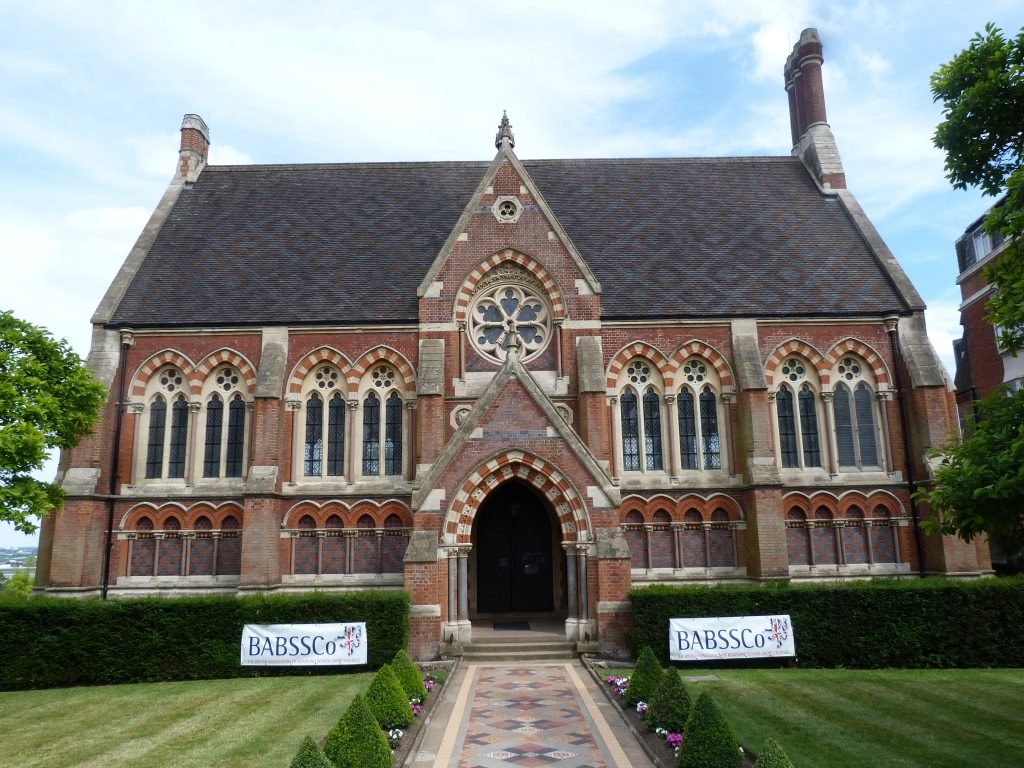Vaughan Library, Harrow School, Harrow
Having transformed his school, Charles Vaughan inexplicably resigned as Headmaster of Harrow in 1859, at the age of forty-three. He became the Vicar of Doncaster and it was proposed to build a new library at Harrow to commemorate Vaughan’s headmastership. Beresford Hope was a pupil at Harrow School between 1833 and 1837 and subsequently took an active interest in its affairs. He probably played a part in the choice of Sir George Gilbert Scott as the architect for a new library and he certainly would have approved of the design that Scott produced. It was one of the first opportunities that Scott had to produce a non-domestic building in the rejected Gothic style. However, it was another old-Harrovian, Lord Palmerston, who by a surprising twist, took a leading role in promoting Scott’s first public building in his High Victorian style.
During the great debate in the House of Commons on 8 July 1861 on Scott’s classical Foreign Office, Buxton chided Palmerston for going to Harrow ‘to lay the foundation stone of a Gothic building’. Palmerston, in winding-up the debate, said:
I am not fond of the Gothic, but, having been applied to lay the stone of a Gothic library, the plan of which was approved by the proper authorities, which was in harmony with a Gothic chapel close to which it was to be placed, and also in keeping with old John Lyon’s school-house, I waived my objection to the Gothic style in attending on that occasion.
Palmerston’s loyalty to his old school was paramount. On 4 July 1861, the seventy-six year old Prime Minister rode the ten miles from London to Harrow, laid the foundation stone of the Vaughan Library and returned, all in pouring rain ‘without changing his wet clothes or eating his lunch’. He knew that Scott was intending to build ‘a Gothic library’, but it is not clear if he realised that it would be in the style that he had rejected for the Foreign Office. In fact the only concession that Scott made to ‘old John Lyon’s school-house’, which was built in the early seventeenth century, was to use red bricks. But Scott was well established at Harrow and the work that he had already carried out there, was clearly liked.
The site is next to Scott’s chapel and characteristically he seized the opportunities presented by the site to expose the side of his chapel and make it part of a memorable High Victorian group with the library as a spectacular memorial to Vaughan’s achievement in turning Harrow into one of the leading English public schools. The main entrance is very formal with a central path of harsh multi-coloured tiles leading into a cavernous porch. Inside, opposite the entrance, is a large transomed bay window extending upwards through the whole height of the library, with a magnificent view across London. The only asymmetrical feature is a small staircase turret, with a conical roof, to the left of the rear elevation, which leads down basement classrooms. The whole building is richly decorated with shiny granite columns with foliated capitals, patterned brickwork within blank arcading and patterned roof tiles. The whole vocabulary of Scott’s High Victorian Gothic style is here including, of course, the alternating voussoirs around all the pointed arches. The builder of the Vaughan Library was Richard Chapman of Harrow, and it was completed in 1863 at a cost of about £12,000. Scott’s friend William Burges called it ‘the best building in Harrow’. It was the first non-domestic application of his ideas for secular architecture and in that location could be seen by many highly influential potential clients.
During the debates in Parliament on the question of style, part of the problem was that it was not possible for M.P.s to look at real buildings in Scott’s High Victorian Gothic style, and it is ironic that by 1862, just as the classical Foreign Office was starting to be built, Scott was at last able to produce several actual buildings in his rejected style. The Vaughan Library, perhaps thanks to Hope, was a major statement in the new style.
Crook, J. M. (ed.), The Strange Genius of William Burges, ‘Art Architect’, 1827-1881 (National Museum of Wales, Cardiff, 1981), p. 245.
Hansard, 8 July 1861, column 517.
Hansard, 8 July 1861, column 540.
Ridley, J., Lord Palmerston (Constable, London, 1970), p. 683.
J. G. C. Minchie, Old Harrow Boys, cited, Chaplin, E., The Book of Harrow (Staples Press, London, 1948), p. 71.
Pevsner, N., and Cherry, B., London 3: North West, Buildings of England (Penguin Books, London, 1991), p. 266.

